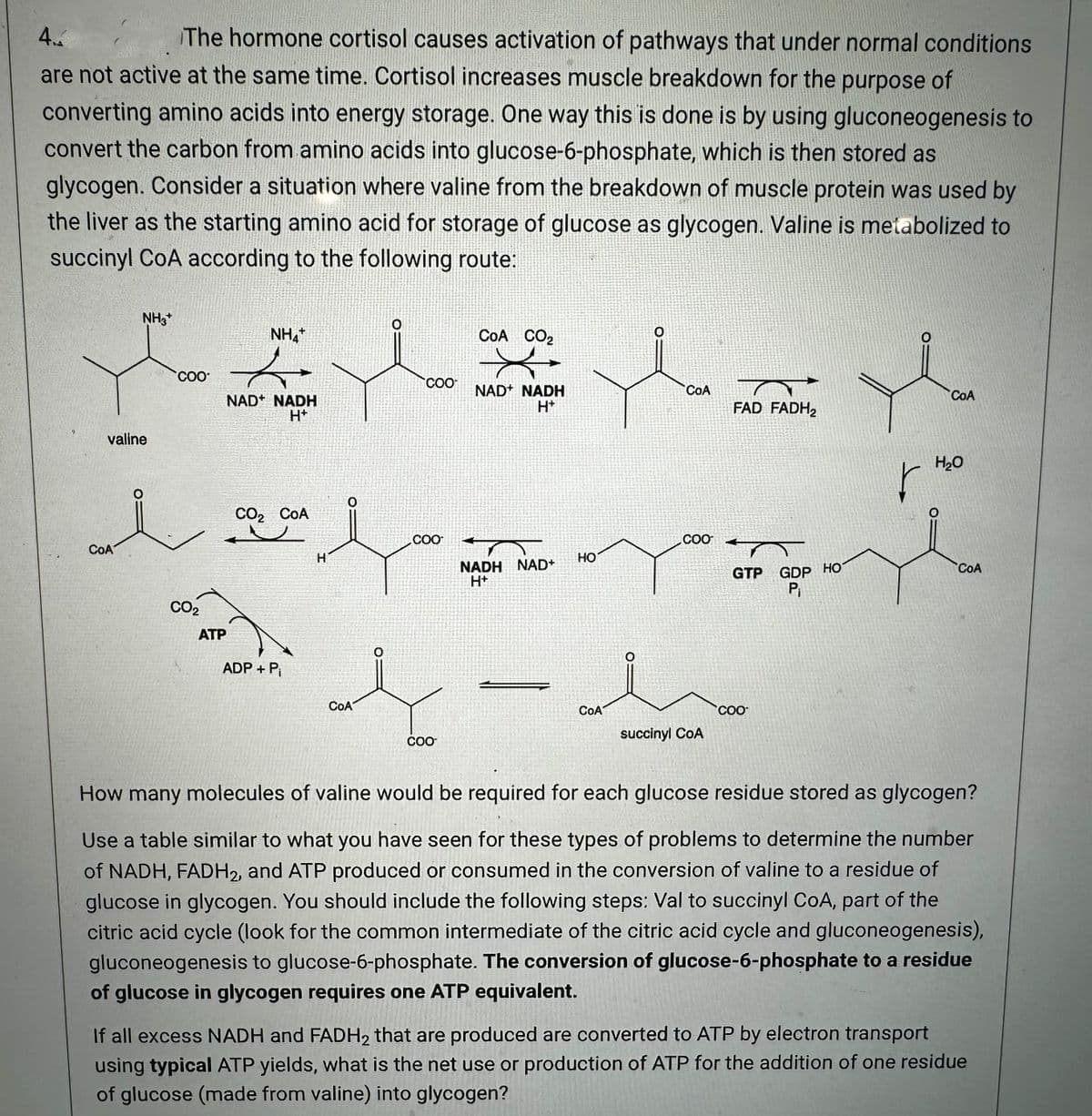The hormone cortisol causes activation of pathways that under normal conditions 4. are not active at the same time. Cortisol increases muscle breakdown for the purpose of converting amino acids into energy storage. One way this is done is by using gluconeogenesis to convert the carbon from amino acids into glucose-6-phosphate, which is then stored as glycogen. Consider a situation where valine from the breakdown of muscle protein was used by the liver as the starting amino acid for storage of glucose as glycogen. Valine is metabolized to succinyl CoA according to the following route: NH3* valine COA 01 COO CO₂ NH4+ L NAD+ NADH H+ ATP CO₂ COA ADP + P₁ COA COO COO COO COA CO₂ NAD+ NADH H+ NADH NAD+ H+ - HO COA CoA COO succinyl COA FAD FADH₂ GTP GDP HO P₁ COO r CoA H₂O COA How many molecules of valine would be required for each glucose residue stored as glycogen? Use a table similar to what you have seen for these types of problems to determine the number of NADH, FADH2, and ATP produced or consumed in the conversion of valine to a residue of glucose in glycogen. You should include the following steps: Val to succinyl CoA, part of the citric acid cycle (look for the common intermediate of the citric acid cycle and gluconeogenesis), gluconeogenesis to glucose-6-phosphate. The conversion of glucose-6-phosphate to a residue of glucose in glycogen requires one ATP equivalent. If all excess NADH and FADH₂ that are produced are converted to ATP by electron transport using typical ATP yields, what is the net use or production of ATP for the addition of one residue of glucose (made from valine) into glycogen?
The hormone cortisol causes activation of pathways that under normal conditions 4. are not active at the same time. Cortisol increases muscle breakdown for the purpose of converting amino acids into energy storage. One way this is done is by using gluconeogenesis to convert the carbon from amino acids into glucose-6-phosphate, which is then stored as glycogen. Consider a situation where valine from the breakdown of muscle protein was used by the liver as the starting amino acid for storage of glucose as glycogen. Valine is metabolized to succinyl CoA according to the following route: NH3* valine COA 01 COO CO₂ NH4+ L NAD+ NADH H+ ATP CO₂ COA ADP + P₁ COA COO COO COO COA CO₂ NAD+ NADH H+ NADH NAD+ H+ - HO COA CoA COO succinyl COA FAD FADH₂ GTP GDP HO P₁ COO r CoA H₂O COA How many molecules of valine would be required for each glucose residue stored as glycogen? Use a table similar to what you have seen for these types of problems to determine the number of NADH, FADH2, and ATP produced or consumed in the conversion of valine to a residue of glucose in glycogen. You should include the following steps: Val to succinyl CoA, part of the citric acid cycle (look for the common intermediate of the citric acid cycle and gluconeogenesis), gluconeogenesis to glucose-6-phosphate. The conversion of glucose-6-phosphate to a residue of glucose in glycogen requires one ATP equivalent. If all excess NADH and FADH₂ that are produced are converted to ATP by electron transport using typical ATP yields, what is the net use or production of ATP for the addition of one residue of glucose (made from valine) into glycogen?
Biochemistry
6th Edition
ISBN:9781305577206
Author:Reginald H. Garrett, Charles M. Grisham
Publisher:Reginald H. Garrett, Charles M. Grisham
Chapter18: Glycolysis
Section: Chapter Questions
Problem 21P
Related questions
Question
100%
P2.4

Transcribed Image Text:The hormone cortisol causes activation of pathways that under normal conditions
4.
are not active at the same time. Cortisol increases muscle breakdown for the purpose of
converting amino acids into energy storage. One way this is done is by using gluconeogenesis to
convert the carbon from amino acids into glucose-6-phosphate, which is then stored as
glycogen. Consider a situation where valine from the breakdown of muscle protein was used by
the liver as the starting amino acid for storage of glucose as glycogen. Valine is metabolized to
succinyl CoA according to the following route:
NH3
valine
COO
i
COA
CO₂
ATP
NH4+
→
NAD NADH
H+
CO₂ COA
ADP + P₁
H
COA
O
COO
COO
COO
COA CO₂
X
NAD NADH
H+
મોંઘ
NADH NAD+
H+
de
COA
HO
COA
COO
succinyl COA
FAD FADH₂
GTP GDP HO
P₁
COO
r
COA
H₂O
CoA
How many molecules of valine would be required for each glucose residue stored as glycogen?
Use a table similar to what you have seen for these types of problems to determine the number
of NADH, FADH2, and ATP produced or consumed in the conversion of valine to a residue of
glucose in glycogen. You should include the following steps: Val to succinyl CoA, part of the
citric acid cycle (look for the common intermediate of the citric acid cycle and gluconeogenesis),
gluconeogenesis to glucose-6-phosphate. The conversion of glucose-6-phosphate to a residue
of glucose in glycogen requires one ATP equivalent.
If all excess NADH and FADH2 that are produced are converted to ATP by electron transport
using typical ATP yields, what is the net use or production of ATP for the addition of one residue
of glucose (made from valine) into glycogen?
Expert Solution
This question has been solved!
Explore an expertly crafted, step-by-step solution for a thorough understanding of key concepts.
This is a popular solution!
Trending now
This is a popular solution!
Step by step
Solved in 2 steps

Recommended textbooks for you

Biochemistry
Biochemistry
ISBN:
9781305577206
Author:
Reginald H. Garrett, Charles M. Grisham
Publisher:
Cengage Learning

Biology: The Dynamic Science (MindTap Course List)
Biology
ISBN:
9781305389892
Author:
Peter J. Russell, Paul E. Hertz, Beverly McMillan
Publisher:
Cengage Learning

Biochemistry
Biochemistry
ISBN:
9781305577206
Author:
Reginald H. Garrett, Charles M. Grisham
Publisher:
Cengage Learning

Biology: The Dynamic Science (MindTap Course List)
Biology
ISBN:
9781305389892
Author:
Peter J. Russell, Paul E. Hertz, Beverly McMillan
Publisher:
Cengage Learning